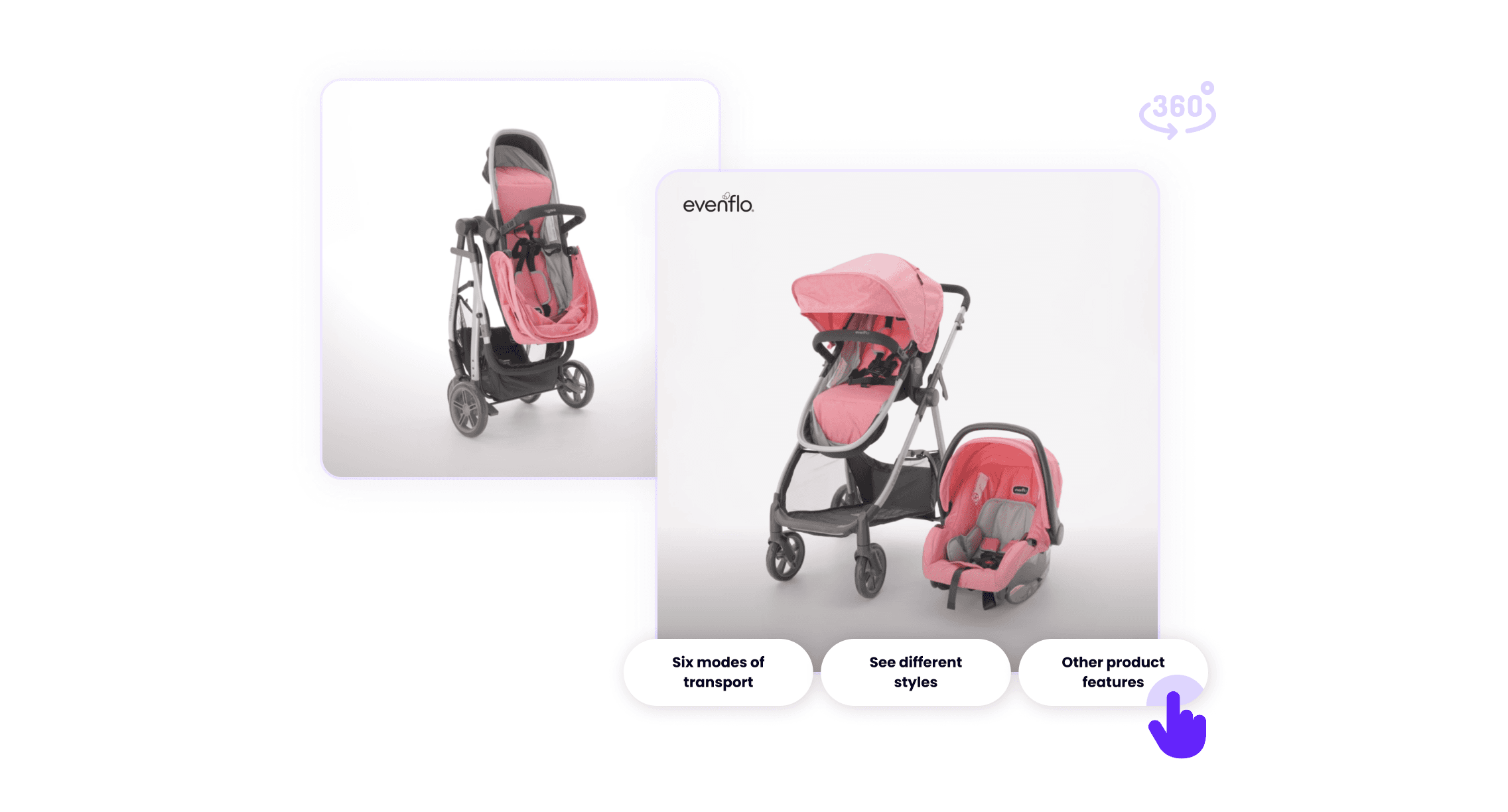Visual Commerce: What It Is and How It's Reshaping Online Retail
Written by:
Mary Beth Wilson
Nov 8, 2023
5 min Read

Ever wish you could touch, hold, or try out a product while shopping online? Imagine being able to see products from every angle with 360-degree views, examine how each feature works with the click of a button, or virtually "try on" clothes and accessories before making a purchase. That’s the future of e-commerce—it's called visual commerce and it's a game-changing concept that makes online shopping more engaging and interactive.
Visual commerce uses the power of images, interactive videos, and augmented reality to create an online shopping experience that's as close to in-store as it gets. Let’s dive deep into the world of visual commerce—what it is, the different types, and the incredible benefits it offers online retailers.
What is Visual Commerce?
Visual commerce uses the power of compelling images and interactive media assets to enhance the online shopping experience and drive sales. A pivotal element for e-commerce websites, it addresses the fundamental challenge of online shopping: the lack of physical interaction with products.
Visual commerce enhances the online shopping experience by providing customers with an in-depth, lifelike understanding of products through high-quality images, videos, and interactive content. The heightened engagement leads to increased trust, reduced cart abandonment rates, higher conversion rates, and ultimately, a more satisfying and successful online shopping journey for consumers. In a competitive e-commerce landscape, integrating visual commerce into product detail pages (PDPs) is crucial for staying relevant and meeting the evolving expectations of modern shoppers.
Types of Visual Commerce
Interactive Content
Interactive elements like 360-degree product views and interactive videos take engagement to a whole new level. They provide a hands-on, try-before-you-buy experience, letting customers explore products in-depth, understand their features, and envision how they'd fit into their lives. These interactive experiences reduce uncertainty and foster a sense of connection, ultimately increasing confidence and conversions. Incorporating interactive content is a game-changer for e-commerce companies, offering customers a shopping experience that's convenient, fun, and fulfilling.

High-Quality Product Images
High-quality images play a crucial role in bridging the physical gap between customers and products in eCommerce. In an online shopping world where you can't touch or try on items, sharp, detailed, and vivid images provide customers with the next best thing. They allow shoppers to scrutinize products, zoom in, and assess every aspect. Captivating product photos can be the deciding factor between a customer making a purchase or moving on to another website or heading into a store. Investing in top-notch visuals is a necessity to stand out in the competitive e-commerce space.
UGC
85% of consumers say that user-generated content (UGC) impacts their purchase decisions more than branded content. UGC is content about your brand—including pictures, videos, testimonials, and reviews—that consumers create and publish on online platforms. Incorporating UGC into PDPs is an effective way to build trust and boost conversions. Below, Caraway takes social proof a step further by allowing customers to upload photos to their reviews.

Augmented Reality
Augmented Reality (AR) helps close the gap between the online and in-store shopping experience by letting customers virtually interact with products in real-time. It allows them to "try on" clothing and accessories, or visualize how a piece of furniture might fit in their home. This immersive AR experience enhances customer engagement, instills confidence in what they’re buying, and helps reduce cart abandonment rates. A game-changer for e-commerce, AR provides a dynamic and memorable shopping journey that closely resembles the in-store experience.
Benefits of Visual Commerce
Enhanced Customer Engagement and User Experience
By letting customers virtually interact with your merchandise, you create a shopping experience that's informative, enjoyable, and similar to what they would get in-store. The more enticing and interactive the visuals, the more likely customers are to stay longer and explore deeper. You’ll also gather valuable insights into their preferences, which can inform your product offerings and marketing strategies, and help you optimize your media assets. Visual commerce isn't just about selling products—it's about creating a memorable, user-centric journey that keeps customers coming back for more.
Higher Conversion Rates
The key to turning browsers into buyers is offering an online shopping experience that's as close to in-person as possible. When customers can see products from every angle and zoom in for a closer look, and virutally “try the product out for themselves,” it eliminates uncertainty and provides the kind of reassurance they get when shopping in a store—and the confidence boost translates directly into higher conversion rates. In fact, e-commerce companies that incorporate compelling visual content typically see conversion rates seven times higher than those who don't.
Lower Cart Abandonment Rates
Cart abandonment, where customers add items to their cart but don't complete the purchase, is a major challenge that costs eCommerce companies $18 billion in lost sales per year. According to the Baymard Institute, 70% of online shopping carts are abandoned on desktop. And on mobile, the average cart abandonment rate is a whopping 86%. But engaging visual assets, like interactive videos, help keep potential buyers engaged and significantly reduce cart abandonment rates. The more shoppers can interact with a product, the more invested they get, and confident they feel.

Lower Return Rates
One key driver of high return rates in e-commerce is the gap between customer expectations and the product they receive. When customers can interact with your items in a more immersive way, they get a clearer understanding of what they're buying, resulting in fewer returns. Customers who have a realistic grasp of a product are less likely to be disappointed upon receipt, which saves time and money for online retailers while also enriching the customer experience.
Final thoughts
Visual commerce is changing the way we shop online. It brings products to life on a screen, allowing consumers to interact with them as if they were in the store. From high-quality images and interactive content, to the magic of augmented reality, visual commerce is an immersive journey that enhances customer engagement, boosts conversion rates, and reduces cart abandonment and return rates. It's the key to offering a user-centric, memorable shopping experience that keeps customers coming back for more.



